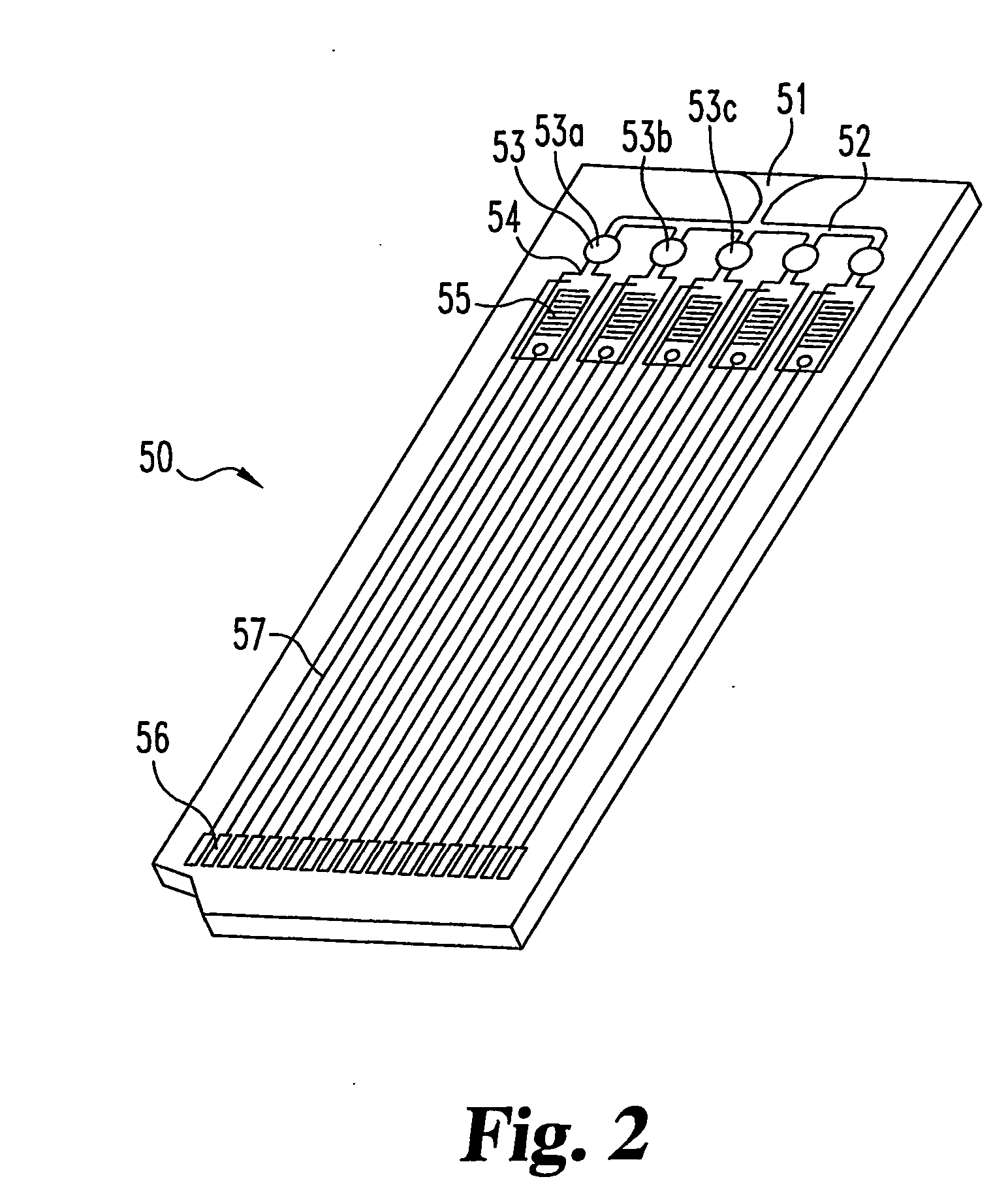Electrochemical affinity biosensor system and methods
a biosensor and electrochemical technology, applied in the field of electrochemical immunoassay systems, reagents, and methods for detecting analytes in fluids, can solve the problems of visual reading, high cost, and high labor intensity of many of these techniques
- Summary
- Abstract
- Description
- Claims
- Application Information
AI Technical Summary
Benefits of technology
Problems solved by technology
Method used
Image
Examples
example 1
Electrochemical Assays of an Osmium-Theophylline Conjugate
[0214] An Os-theophylline conjugate was prepared as illustrated in FIG. 20. This redox reversible conjugate was evaluated with a series of electrochemical measurements designed to develop an assay response for theophylline. IDA microelectrodes were fabricated as described herein using photolithographic techniques. The IDAs included gold electrode structures with 50 finger pairs each having a width (W) of about 21 μm and a gap (Wg) of 10, 15, and 21 μm and length (b) of 6 mm. Each IDA also contained two additional gold electrode regions for use as a counter and reference electrode. The electrochemical measurements were performed using a CH Instruments bipotentiostat model 802A or 832A. Bipotentiostatic amperometric measurements were made for IDA amplification and a single potential amperometric technique was used for enzyme amplification. Each measurement required about 20 μL sample pipette onto the electrode when using an ex...
example 2
Electrochemical Assays of an Osmium-Amphetamine Conjugate
[0221] An Os-amphetamine conjugate (10) was prepared as illustrated in FIG. 19. This redox reversible conjugate was evaluated in a series of electrochemical assays. Interdigitated array (IDA) microelectrodes were fabricated as described herein using photolithographic techniques. Each IDA contained 50 pairs of “fingers” each finger had a width of 21 μm and a gap width between the fingers of 15 μm. The electrochemical measurements were performed using a CH Instruments bipotentiostat model 802A or 832A. Bipotentiostatic amperometric measurements were made for IDA amplification and a single potential amperometric technique was used for enzyme amplification. Each measurement required about 20 μL sample pipette onto the electrode when using an external reference electrode or 5-10 μl with an internal reference electrode of Ag / AgCl ink and a capillary roof over the active electrode structures
[0222]FIG. 43 shows a cyclic voltammogram...
example 3
Osmium-Biotin Model System with 2 μm IDA
[0227] Interdigitated array electrodes were custom fabricated for Roche Diagnostics by Premitec, Inc., Raleigh, N.C. Each IDA contained 750 pairs of electrodes each 6 mm in length with a gap and width of 2 μm. The interdigitated region for these electrodes totaled 36 mm2. This large dimension was selected based on practical considerations of achieving lower detection limits. Instruments, especially a portable handheld bipotentiostat, have limitations as to the minimum currents that can be detected. At the time, an assumption was made that 1 nA would be the lowest current that would be measured for an assay due to noise considerations of a handheld device. Using this information along with predicted current responses, the dimensions of the electrodes were determined to allow a sizeable improvement in immunoassay sensitivity. In addition these electrodes were also fabricated to compare the calculated sensitivity to that actually observed to dem...
PUM
| Property | Measurement | Unit |
|---|---|---|
| Time | aaaaa | aaaaa |
| Time | aaaaa | aaaaa |
| Time | aaaaa | aaaaa |
Abstract
Description
Claims
Application Information
 Login to View More
Login to View More - R&D
- Intellectual Property
- Life Sciences
- Materials
- Tech Scout
- Unparalleled Data Quality
- Higher Quality Content
- 60% Fewer Hallucinations
Browse by: Latest US Patents, China's latest patents, Technical Efficacy Thesaurus, Application Domain, Technology Topic, Popular Technical Reports.
© 2025 PatSnap. All rights reserved.Legal|Privacy policy|Modern Slavery Act Transparency Statement|Sitemap|About US| Contact US: help@patsnap.com



